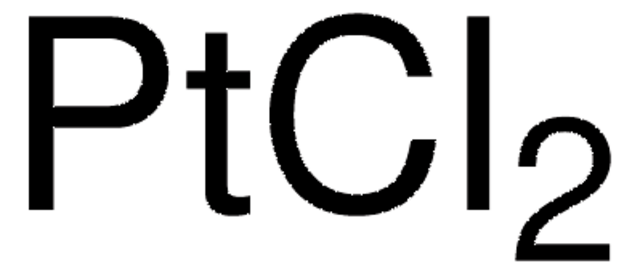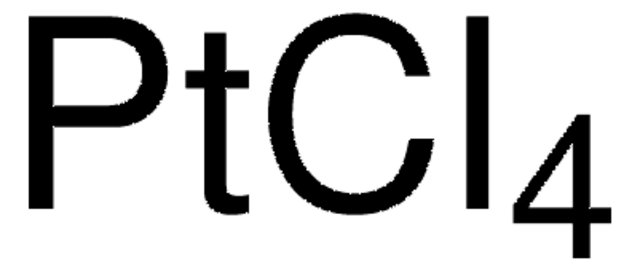Key Documents
520853
Potassium tetrachloroplatinate(II)
≥99.9% trace metals basis
Synonim(y):
Potassium platinum(II) chloride
About This Item
Polecane produkty
Poziom jakości
Próba
≥99.9% trace metals basis
Postać
powder or crystals
skład
Pt, ≥46.2%
zanieczyszczenia
≤1000.0 ppm Trace Metal Analysis
gęstość
3.38 g/mL at 25 °C (lit.)
ciąg SMILES
[K+].[K+].Cl[Pt--](Cl)(Cl)Cl
InChI
1S/4ClH.2K.Pt/h4*1H;;;/q;;;;2*+1;+2/p-4
Klucz InChI
RVRDLMCWUILSAH-UHFFFAOYSA-J
Szukasz podobnych produktów? Odwiedź Przewodnik dotyczący porównywania produktów
Opis ogólny
Zastosowanie
- As a precursor to prepare platinum nanoparticles and mesoporous platinum nanospheres with tunable pore sizes.
- As a catalyst for selective methane oxidation through C-H activation. In addition, to synthesize octahedral Pd@Pt1.8Ni nanocrystals with an ultrathin PtNi alloy shell. The nanocrystals exhibited better ORR activity and durability than the commercial Pt/C for fuel cells.
- To prepare Pt atomic clusters were synthesized using a one-step carbon-defect-driven electroless deposition method. These catalysts demonstrated low overpotential, high activity for the hydrogen evolution reaction, exceptional stability, and improved utilization efficiency of Pt. The Pt-AC/DG (Atomic Clusters/Defective Graphene) cathode showed excellent hydrogen production activity, remarkable stability, and significantly reduced Pt usage compared to the Pt/C catalyst.
- As a starting material to synthesize cyclometalated platinum(II) complexes with long-lived luminescence in solution.
Cechy i korzyści
Hasło ostrzegawcze
Danger
Zwroty wskazujące rodzaj zagrożenia
Zwroty wskazujące środki ostrożności
Klasyfikacja zagrożeń
Acute Tox. 3 Oral - Eye Dam. 1 - Resp. Sens. 1 - Skin Irrit. 2 - Skin Sens. 1
Kod klasy składowania
6.1C - Combustible acute toxic Cat.3 / toxic compounds or compounds which causing chronic effects
Klasa zagrożenia wodnego (WGK)
WGK 1
Temperatura zapłonu (°F)
Not applicable
Temperatura zapłonu (°C)
Not applicable
Środki ochrony indywidualnej
Eyeshields, Faceshields, Gloves, type P2 (EN 143) respirator cartridges
Wybierz jedną z najnowszych wersji:
Masz już ten produkt?
Dokumenty związane z niedawno zakupionymi produktami zostały zamieszczone w Bibliotece dokumentów.
Klienci oglądali również te produkty
Nasz zespół naukowców ma doświadczenie we wszystkich obszarach badań, w tym w naukach przyrodniczych, materiałoznawstwie, syntezie chemicznej, chromatografii, analityce i wielu innych dziedzinach.
Skontaktuj się z zespołem ds. pomocy technicznej














